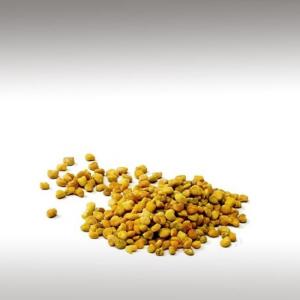
BEE POLLEN - INGREDIENTS

BASE / GENERAL DATA
Information submited: March 30, 2016 Modified: May 18, 2018 By: OperaDreamhouse
Bee Pollen comes in tiny little golden - coloured granules that are sweet to taste. It is gathered while bees visit flowers collecting nectar, some is brushed off their legs and collected when they enter the hive.
Bee Pollen contains vitamins, minerals, carbohydrates, lipids, and protein. It comes from the Pollen that collects on the bodies of bees. Bee Pollen is the Pollen ball that has been packed by worker honeybees into pellets.
The old Egyptians describe Pollen as "A Life - Giving Dust". Pollen and its nutritional value is still surrounded by mysteries. It is called the only perfectly complete food. It is one of nature’s most completely nourishing foods, with nearly all the nutrients required by humans.
Foraging bees bring pollen back to the hive, where they pass it off to other worker bees, who pack the Pollen into cells with their heads. During collection and possibly packing, the Pollen is mixed with nectar and bee salivary secretions.
The old Egyptians describe Pollen as "A Life - Giving Dust". Pollen and its nutritional value is still surrounded by mysteries. It is called the only perfectly complete food. It is one of nature’s most completely nourishing foods, with nearly all the nutrients required by humans.
Foraging bees bring pollen back to the hive, where they pass it off to other worker bees, who pack the Pollen into cells with their heads. During collection and possibly packing, the Pollen is mixed with nectar and bee salivary secretions.
Bee Pollen is the primary source of protein for the hive. When the Pollen ball is complete, a single female lays an egg on top of the pollen ball, and seals the brood cell. The term “Bee Bread” is reserved for the original Bee Pollen stored in the combs. Thus, the product cannot be called “Home Bee Bread” or fermented Pollen.
Bee Pollen was eaten only by baby bees to help them grow. These days, people can eat Bee Pollen too.
Chemical structure:
The average composition is said to be 40 - 60% simple sugars (fructose and glucose), 2 - 60% proteins, 3% minerals and vitamins, 1 - 32% fatty acids, and 5% diverse other components.
Fresh, bee collected Pollen contains about 20-30 g Water per 100 g. This high humidity is an ideal culture medium for micro-organisms like bacteria and yeast. For prevention of spoilage and for preservation of a maximum quality the Pollen has to be harvested daily and immediately placed in a freezer. After two days of storage in the freezer, the pest insects will be killed.
Self life: A microbiological and sensory point of view Pollen remains stable until 1,5 years of storage at room temperature. Under these conditions Pollen keeps its sensory and microbiological quality for a storage period of 2 years, if stored in a cool, dry and dark place. Pollen loses a considerable amount of its antioxidant activity (about 59%) after one year.
Dried Pollen stored at room temperature: 12 months;
Dried Pollen packed in vacuum: 24 months;
Frozen fresh pollenstored in the freezer: 12 months.
Bee Pollen was eaten only by baby bees to help them grow. These days, people can eat Bee Pollen too.
Chemical structure:
The average composition is said to be 40 - 60% simple sugars (fructose and glucose), 2 - 60% proteins, 3% minerals and vitamins, 1 - 32% fatty acids, and 5% diverse other components.
Fresh, bee collected Pollen contains about 20-30 g Water per 100 g. This high humidity is an ideal culture medium for micro-organisms like bacteria and yeast. For prevention of spoilage and for preservation of a maximum quality the Pollen has to be harvested daily and immediately placed in a freezer. After two days of storage in the freezer, the pest insects will be killed.
Self life: A microbiological and sensory point of view Pollen remains stable until 1,5 years of storage at room temperature. Under these conditions Pollen keeps its sensory and microbiological quality for a storage period of 2 years, if stored in a cool, dry and dark place. Pollen loses a considerable amount of its antioxidant activity (about 59%) after one year.
Dried Pollen stored at room temperature: 12 months;
Dried Pollen packed in vacuum: 24 months;
Frozen fresh pollenstored in the freezer: 12 months.

SPIRITUAL PRACTISES DATA

MEDICINE / HEALTH DATA

BEAUTY / COSMETICS DATA

FOOD / COOKING DATA
COMMENTS
No comments.
Newest mixtures containing Bee Pollen:

Face and body gentle oil cleanser
May 26, 2016


